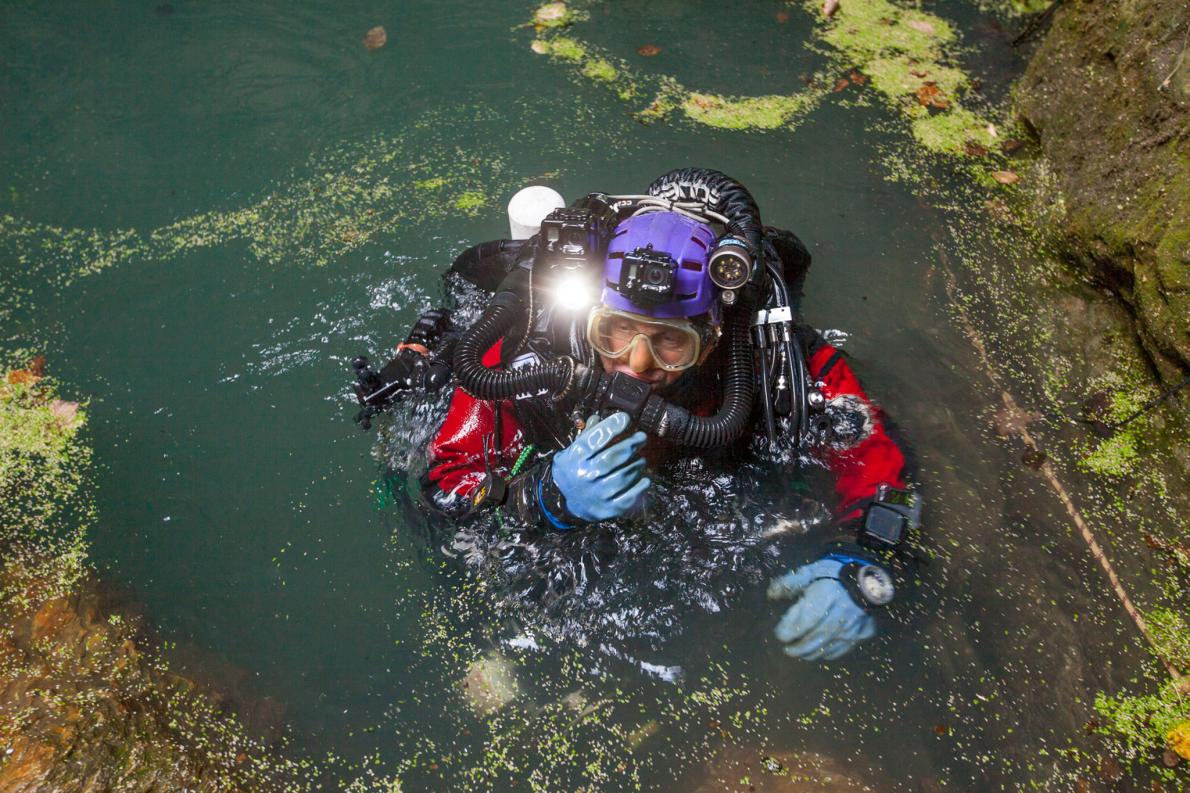Deepest Underwater Cave Discovered

Czech-Polish expedition overcomes dive challenges to get to the bottom of a European abyss.

A team of explorers in the Czech Republic has just discovered the world’s deepest underwater cave. The legendary Polish diver Krzysztof Starnawski, leading a Czech-Polish expedition supported in part by a National Geographic grant, found on September 27 that the flooded limestone abyss measures 404 meters (1,325 feet) deep.
That beats the previous record holder, 392-meter (1,286-foot) Pozzo del Merro in Italy, by 12 meters (39 feet).
Starnawski first explored the Czech cave, named Hranická Propast, in 1999. The limestone formation developed in an unusual way, he told National Geographic last year, that suggested it could extend down a great distance: hot water saturated with carbon dioxide bubbled up like a volcano, which wore away the rock from the bottom up. The team said the water made their exposed skin itch.

Over the past two years, Starnawski completed dives that offered further clues. In 2014, he reached a depth of 200 meters (656 feet)—which he thought was the bottom. Instead, he found an extremely narrow opening called a “squeeze passage” that led to another vertical tunnel, pitch-black and circled by rough limestone. He lowered a probe through the tunnel and ran out of line at 384 meters (1,260 feet), just shy of the Italian cave’s limit.
Last year, Starnawski returned to Hranická Propast to find that the squeeze passage had crumbled, widening the aperture. He was able to dive through it to a depth of 265 meters (869 feet). He released another probe, and this time, it hit bottom at 370 meters (1,214 feet), likely on top of a pile of debris from the collapsed passage above.

On this week's dive, technicians who stayed topside guided an ROV into the deep. Starnawski spoke with National Geographic Adventure about his team’s discovery and the challenge of exploring at such forbidding depths.

What did you hope to achieve on this expedition?
The dive on September 27 was one in the long series of dives that I did in the last 20 years in Hranická Propast. They all had the same goal: to explore the cave further and deeper. As the expedition leader for the last several years, I've prepared the equipment and the route in and out for the ROV’s dive, so the ROV could go beyond the limits of a human diver, and get through the restricted passage and between the fallen logs and trees.
How did your dive and the ROV’s search for the bottom unfold?
During this push, the most important part of the job was done by the robot. I scuba dived down to 200 meters just before the ROV’s deployment to put in the new line for the robot to follow. The goal was to give the ROV a good start from there to the deepest part of the cave. I came back to the surface, and then we went down with the robot to a depth of 60 meters (197 feet). From there, the team at the surface navigated it, via fiber-optic cable, down along my new line to 200 meters deep. Then it went down to explore the uncharted territory—to the record-breaking depth of 404 meters.
Why did you opt to deploy an ROV at that point, instead of diving farther down?
My intention was not to achieve the deepest dive by a human, but to assist the exploration by the ROV. In this cave we wanted to explore beyond the 400-meter limit. It can't be done, so far, by a scuba diver in the cave. So I invited Bartlomiej Grynda from GRALmarine, with his custom-built ROV, to send the robot as deep as possible to explore the cave. The results were astonishing.

What was going through your mind during your dive?
I'm always focused on the task. I've been to this cave many times before, and a dozen times to the depth of approximately 200 meters, so I felt pretty confident. The goal for this particular dive was to make the ROV operation smooth, easy, and most effective. This time that meant showing the robot the way through the cave.
But robots do not do the job instead of us. We, the humans, are still needed to show them where to go.
How did you verify the new record?
The ROV that reached 404 meters has a depth gauge that was tested and certified by our state commission, so we are 100 percent sure the measurements were accurate.
After diving to a depth of 200 meters, how long did you have to sit in the decompression chamber near the surface? How did you pass the time?
In the dry decompression bell that is underwater, I spend between two and four hours. And it's 40 percent of the entire dive time. Usually I read. I laminate book pages to prevent paper from being destroyed by water. Crime stories and political thrillers are good reads!








